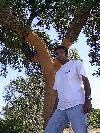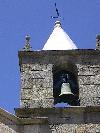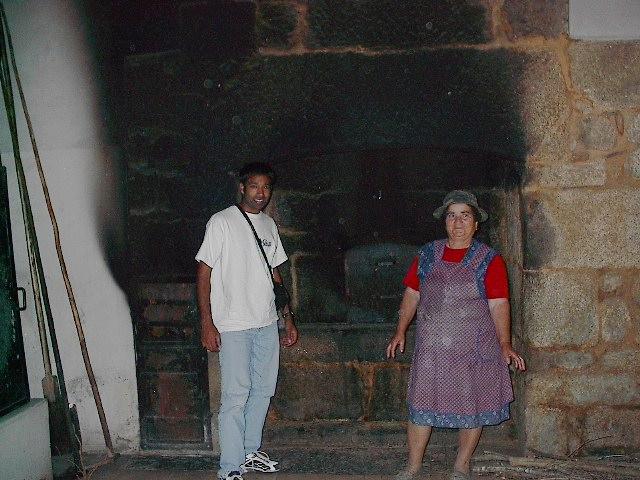Idanha-a-Velha

 |
On the way to Idanha-a-Velha we drove through more of the olive groves, and the sides of the roads were lined with cork trees. The lighter part of the tree is where they've cut off the outer layer of bark. The outer layer is very thick, and will grow back fairly quickly. They cut all the way around the tree, then take the pieces of bark off in large sections. When they do this they are careful not to damage the living part of the bark, which is what you're seeing as the yellowish part of this tree. As the bark grows back, the tree looks brown, then it darkens until it's almost black, which is when it's time to harvest the bark again. |
| In the village of Idenha-a-Velha we weren't able to see too much because we got there shortly after our lunch and most people were still having lunch. This bell tower caught our eyes and we walked around the small church that housed it. It's an old bronze bell, but if you look at the |
 |
| close-up, you can see that modern technology has been mixed in with the old. To the right of the bell is the electric solenoid that is used to ring the bell in place of the pull ropes. There were some old roman ruins nearby, but we couldn't get access to most of them. |
 |
 |
Luis throws up his arms in frustration as we walk down the streets of Idanha-a-Velha because we haven't found a guide and we're not really sure where anything is. We saw this stork up at the top of a chapel, but she couldn't help us. Eventually, we wandered long enough to find some of the ruins. |
 |
 |
We had to wander off the beaten path to find some of the real treasures. Oklahoma Doty (the famous archaelogist/adventurer) started teaching us about the inhabitant of this sarcophagus. Here he's pointing out the Celtic symbols and explaining their meaning. He went on to tell us that the lid was broken when |
 |
| the victim decided he wanted out. We of course believed everything he told us (lots of smiling and nodding). |
 |
There was a closed in area containing a collection of artifacts that have been excavated from this area. This time Luis took over the tour and started to tell us all about the stone blocks engraved with text. Very few of them contained complete texts that we could decifer, but I think we came |
| to an agreement about the meaning of this one. It clearly an advertisement for the Roman equivalent to long distance phone service. They just can't seem to leave anyone alone. |
 |
 |
This building was in the process of being renovated during our visit, but I got close enough to see some of the ancient celtic markings that have survived the ages. Some of the workers were taking a break in the shade of a nearby olive tree. That's another olive grove in the background. |
 |
| As we walked back to the car I learned a little more about small town life. Some of the basic items I've always taken for granted aren't quite so easy to maintain here. Spaces to wash clothes and ovens are often set up in central areas and shared by the community. Here's a communal oven that's still in use. They were making some cakes and cookies while we were there. |
 |
 Send all questions or comments about this page to Aamir.
Send all questions or comments about this page to Aamir.
|